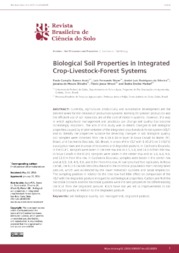Biological soil properties in integrated crop-livestock-forest systems.
Biological soil properties in integrated crop-livestock-forest systems.
Author(s): ASSIS, P. C. R.; STONE, L. F.; SILVEIRA, A. L. R. da; OLIVEIRA, J. de M.; WRUCK, F. J.; MADARI, B. E.
Summary: Currently, agricultural productivity and sustainable development are the desired bases for the creation of production systems. Farming for greater production and the efficient use of soil resources are at the core of modern systems. However, the way in which agricultural management and practices can change soil quality has become increasingly important. The aim of this study was to detect changes in soil biological properties caused by implementation of the integrated crop-livestock-forest system (iCLF) and to identify the properties suitable for detecting changes in soil biological quality. Soil samples were collected from the 0.00-0.10 m layer in Nova Canaã do Norte, MT, Brazil, and Cachoeira Dourada, GO, Brazil, in areas of the iCLF with 1 (iCLF1) or 3 (iCLF3) eucalyptus rows and in areas of recovered and degraded pasture. In Cachoeira Dourada, in the iCLF1, samples were taken in the tree row and at 2.5, 5.0, and 10.0 m from this row. In Nova Canaã in the iCLF3, samples were taken in the center row and at 3.0, 6.0, 9.0, and 12.0 m from this row. In Cachoeira Dourada, samples were taken in the center row and at 1.5, 3.0, 4.5, 6.0, and 9.0 m from this row. All samples had five replicates. In Nova Canaã, the iCLF1 caused less disturbance in the microbial population than the degraded pasture, which was evidenced by the lower metabolic quotient and basal respiration. The sampling position in relation to the tree row had little effect on comparison of the iCLF with the degraded pasture in regard to soil biological properties. Carbon and N of the microbial biomass and the microbial quotient were the best properties for differentiating the iCLF from the degraded pasture. ICLFs have not yet led to improvements in soil biological quality in relation to the degraded pasture.
Publication year: 2017
Types of publication: Journal article
Unit: Embrapa Rice & Beans
Observation
Some of Embrapa's publications are published as ePub files. To read them, use or download one of the following free software options to your computer or mobile device. Android: Google Play Books; IOS: iBooks; Windows and Linux: Calibre.
Access other publications
Access the Agricultural Research Database (BDPA) to consult Embrapa's full library collection and records.
Visit Embrapa Bookstore to purchase books and other publications sold by Embrapa.

